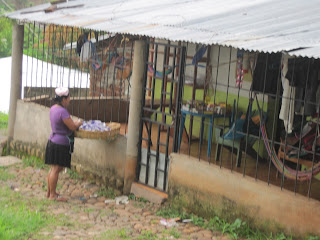Professor Ayalla spoke to us about the current situation in El Salvador. He stated that after the Peace Accords (Peace Agreement signed by both sides of the 12 year civil war-the government, the Nationalist Republican Alliance (ARENA) and the Farabundo Marti National Liberation Front (FMLN), a gorilla organization that was allowed to a form political party and participate in elections after the signing), four presidents dedicated themselves to develop Neoliberal policies in El Salvador. This included: private decision-banking, telephone companies, and pension plans were privatized and the economy was dollarized. This actually resulted in increased unemployment, lack of education, poverty, and crime. People were struggling to provide the basic necessities for their families, often males would quit school to work and females would stay home to take care of the home, siblings, or to help with the animals or farms. This struggle to survive and lack of education is the reason many citizens had very little interest or time to invest in politics. However, most Salvadorans did wish for change and on June 1st, 2009, the first Leftist president in the history of El Salvador, Mauricio Funes, took power.
The amount of positive impact the Leftist government has had on the country is debatable. There have been some positive policies enacted but there is definitely a long way to go. Since Mauricio Funes took power, the government has invested in social spending. They have:
-provided uniforms, shoes, and school supplies for every student (The average school level in El Salvador is 6 years. Lack of education makes it difficult for the country to develop).
-purchased the fabric for the uniforms from Salvadoran businesses and contracted with small local businesses to make the uniforms, creating more jobs for the people of El Salvador.
-provided subsidies for propane gas, public transportation, and school lunch programs.
School children on a field trip to the museum.
The money for these and other government programs comes from taxes (mostly paid by the middle class) and from international loans. Even with these changes, the official unemployment rate in El Salvador is 7% but the underemployment rate is 43% meaning that 50% of the labor force is facing unemployment problems. The average minimum salary in El Salvador is just $200 per month and much less in the rural areas, $2 or less per day for many.
Crime is rampant in El Salvador. As stated in an earlier post, El Salvador has the second highest murder rate in the world. The current statistics state that there are 7 homicides each day in El Salvador. This is a result largely due to extreme poverty, lack of education and deportation of Salvadoran gang members from the U.S. Carlos stated that 150 Salvadorans leave El Salvador (most headed for the United States) every day in search for a better life and 50 people are deported every day from the United States. Often times, these are young boys who no longer have a family in El Salvador, thus they turn to the gangs for support. I will discuss more about gangs in a future post.
Woman selling bread in Suchitoto.
She moves on to the next house carrying the basket on her head.
House/yard in a rural area. We were driving so it was difficult to get a good picture.
There were dogs all over El Salvador, in the city and in the rural areas-most were very skinny. This little one happened to be in a yard but many just roamed the streets and neighborhoods. The memory of seeing all if those sad dogs will stay with me for a very long time. This picture represents that memory for me.





No comments:
Post a Comment